System Analysis and Design Report for Mental Health Information System
VerifiedAdded on 2020/03/01
|9
|1726
|193
Report
AI Summary
This report presents a system analysis and design for a mental health information system, focusing on the needs of a National Youth Mental Health Foundation (headspace). It begins with a stakeholder analysis, identifying internal operations, internal executive, external executive, and external operation stakeholders, and their respective influences and importance. A stakeholder map visually represents these relationships. The report then outlines a questionnaire designed for patients (external operation stakeholders) to gather feedback on the proposed system, including questions about their experiences with mental health professionals, preferences for information sharing, and desired system functionalities. A use case diagram illustrates the interactions between different users (Headspace worker and ED worker) with the system, describing use cases such as managing patient records, recording patient stories, and admitting/discharging patients. The report provides detailed use case descriptions, particularly for the 'Record patient story' scenario. The report also includes a main success scenario for the 'Record patient story' use case. The report concludes with a list of references.

2017
SYSTEM ANALYSIS AND DESIGN
Student name
STUDENT ID
SYSTEM ANALYSIS AND DESIGN
Student name
STUDENT ID
Paraphrase This Document
Need a fresh take? Get an instant paraphrase of this document with our AI Paraphraser
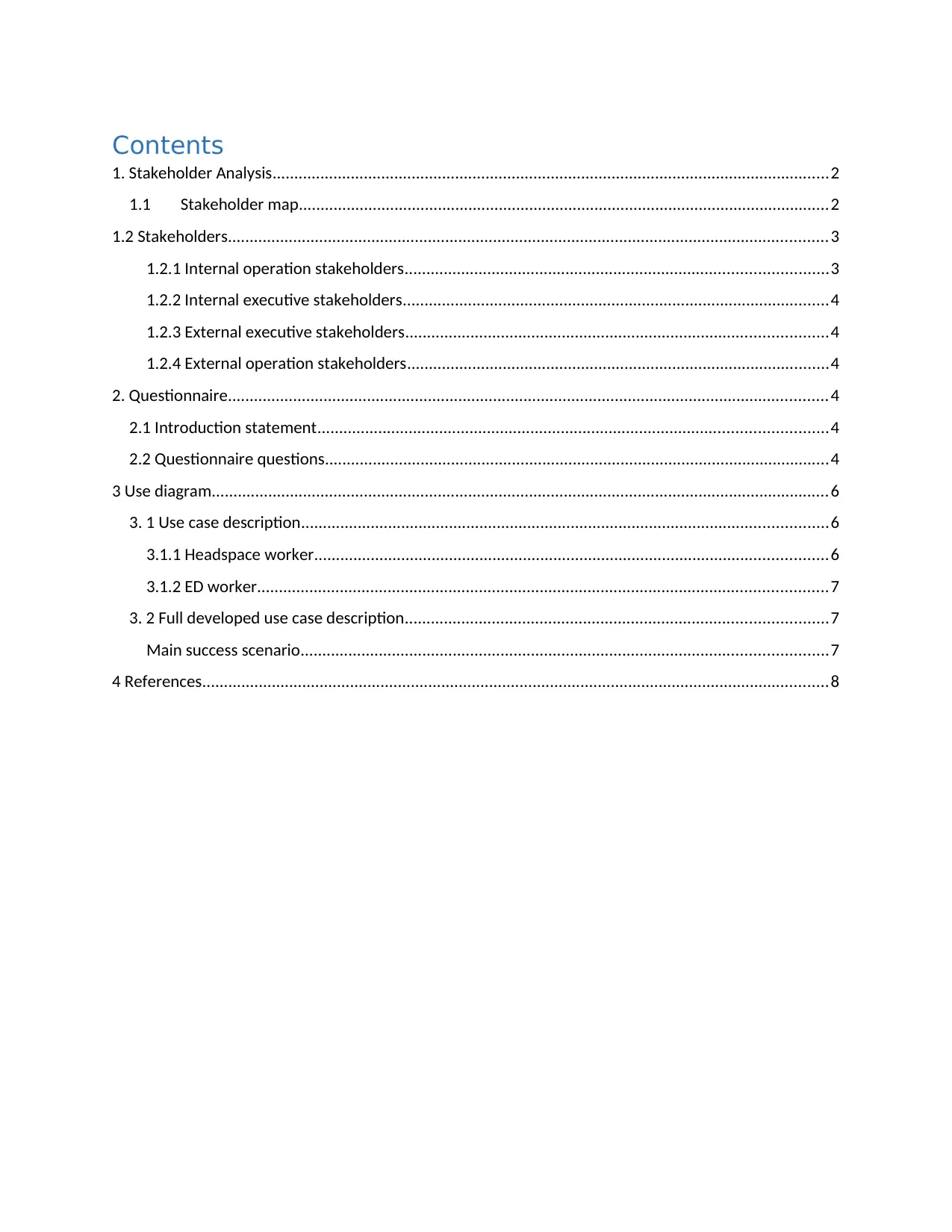
Contents
1. Stakeholder Analysis................................................................................................................................2
1.1 Stakeholder map..........................................................................................................................2
1.2 Stakeholders..........................................................................................................................................3
1.2.1 Internal operation stakeholders.................................................................................................3
1.2.2 Internal executive stakeholders..................................................................................................4
1.2.3 External executive stakeholders.................................................................................................4
1.2.4 External operation stakeholders.................................................................................................4
2. Questionnaire..........................................................................................................................................4
2.1 Introduction statement.....................................................................................................................4
2.2 Questionnaire questions....................................................................................................................4
3 Use diagram..............................................................................................................................................6
3. 1 Use case description.........................................................................................................................6
3.1.1 Headspace worker......................................................................................................................6
3.1.2 ED worker...................................................................................................................................7
3. 2 Full developed use case description.................................................................................................7
Main success scenario.........................................................................................................................7
4 References................................................................................................................................................8
1. Stakeholder Analysis................................................................................................................................2
1.1 Stakeholder map..........................................................................................................................2
1.2 Stakeholders..........................................................................................................................................3
1.2.1 Internal operation stakeholders.................................................................................................3
1.2.2 Internal executive stakeholders..................................................................................................4
1.2.3 External executive stakeholders.................................................................................................4
1.2.4 External operation stakeholders.................................................................................................4
2. Questionnaire..........................................................................................................................................4
2.1 Introduction statement.....................................................................................................................4
2.2 Questionnaire questions....................................................................................................................4
3 Use diagram..............................................................................................................................................6
3. 1 Use case description.........................................................................................................................6
3.1.1 Headspace worker......................................................................................................................6
3.1.2 ED worker...................................................................................................................................7
3. 2 Full developed use case description.................................................................................................7
Main success scenario.........................................................................................................................7
4 References................................................................................................................................................8
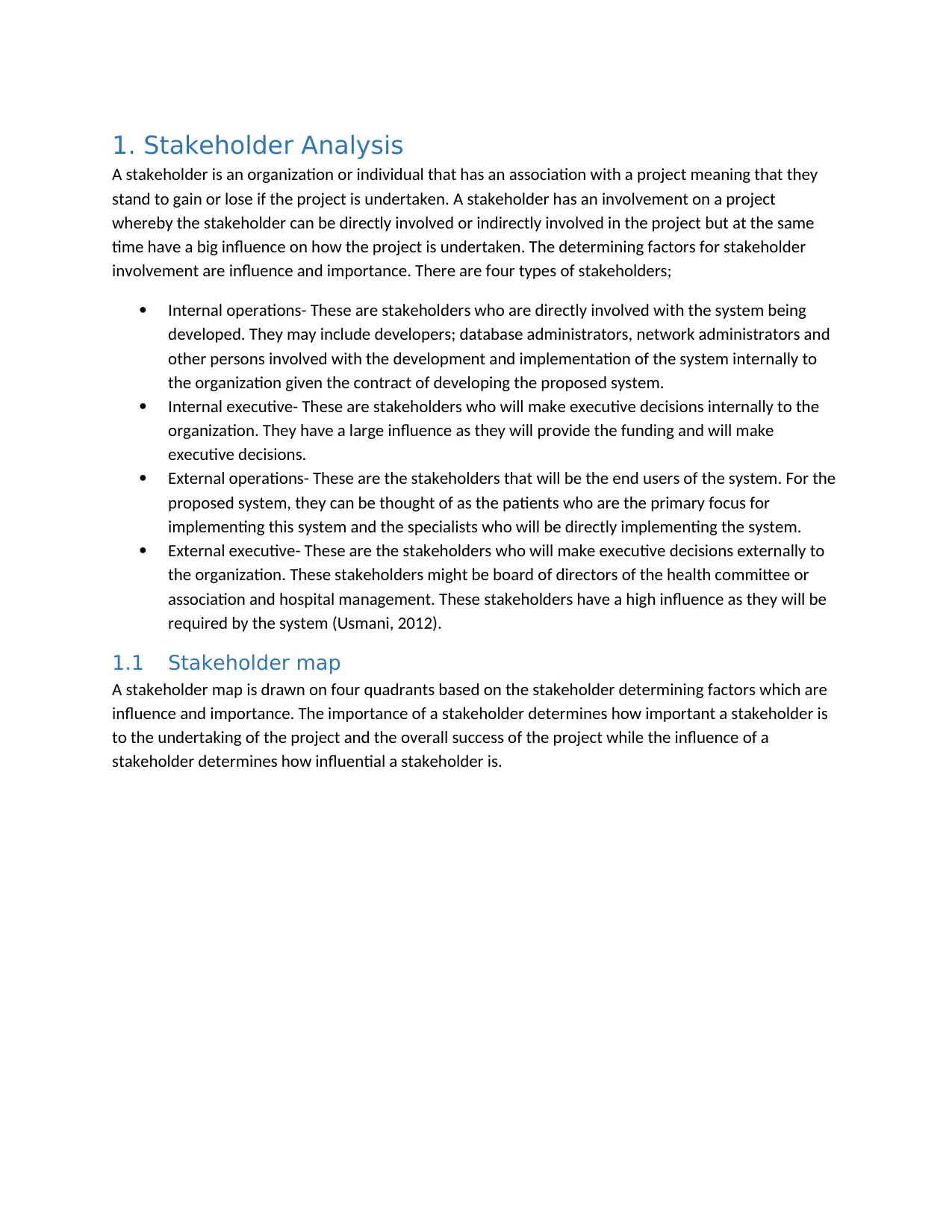
1. Stakeholder Analysis
A stakeholder is an organization or individual that has an association with a project meaning that they
stand to gain or lose if the project is undertaken. A stakeholder has an involvement on a project
whereby the stakeholder can be directly involved or indirectly involved in the project but at the same
time have a big influence on how the project is undertaken. The determining factors for stakeholder
involvement are influence and importance. There are four types of stakeholders;
Internal operations- These are stakeholders who are directly involved with the system being
developed. They may include developers; database administrators, network administrators and
other persons involved with the development and implementation of the system internally to
the organization given the contract of developing the proposed system.
Internal executive- These are stakeholders who will make executive decisions internally to the
organization. They have a large influence as they will provide the funding and will make
executive decisions.
External operations- These are the stakeholders that will be the end users of the system. For the
proposed system, they can be thought of as the patients who are the primary focus for
implementing this system and the specialists who will be directly implementing the system.
External executive- These are the stakeholders who will make executive decisions externally to
the organization. These stakeholders might be board of directors of the health committee or
association and hospital management. These stakeholders have a high influence as they will be
required by the system (Usmani, 2012).
1.1 Stakeholder map
A stakeholder map is drawn on four quadrants based on the stakeholder determining factors which are
influence and importance. The importance of a stakeholder determines how important a stakeholder is
to the undertaking of the project and the overall success of the project while the influence of a
stakeholder determines how influential a stakeholder is.
A stakeholder is an organization or individual that has an association with a project meaning that they
stand to gain or lose if the project is undertaken. A stakeholder has an involvement on a project
whereby the stakeholder can be directly involved or indirectly involved in the project but at the same
time have a big influence on how the project is undertaken. The determining factors for stakeholder
involvement are influence and importance. There are four types of stakeholders;
Internal operations- These are stakeholders who are directly involved with the system being
developed. They may include developers; database administrators, network administrators and
other persons involved with the development and implementation of the system internally to
the organization given the contract of developing the proposed system.
Internal executive- These are stakeholders who will make executive decisions internally to the
organization. They have a large influence as they will provide the funding and will make
executive decisions.
External operations- These are the stakeholders that will be the end users of the system. For the
proposed system, they can be thought of as the patients who are the primary focus for
implementing this system and the specialists who will be directly implementing the system.
External executive- These are the stakeholders who will make executive decisions externally to
the organization. These stakeholders might be board of directors of the health committee or
association and hospital management. These stakeholders have a high influence as they will be
required by the system (Usmani, 2012).
1.1 Stakeholder map
A stakeholder map is drawn on four quadrants based on the stakeholder determining factors which are
influence and importance. The importance of a stakeholder determines how important a stakeholder is
to the undertaking of the project and the overall success of the project while the influence of a
stakeholder determines how influential a stakeholder is.
⊘ This is a preview!⊘
Do you want full access?
Subscribe today to unlock all pages.

Trusted by 1+ million students worldwide
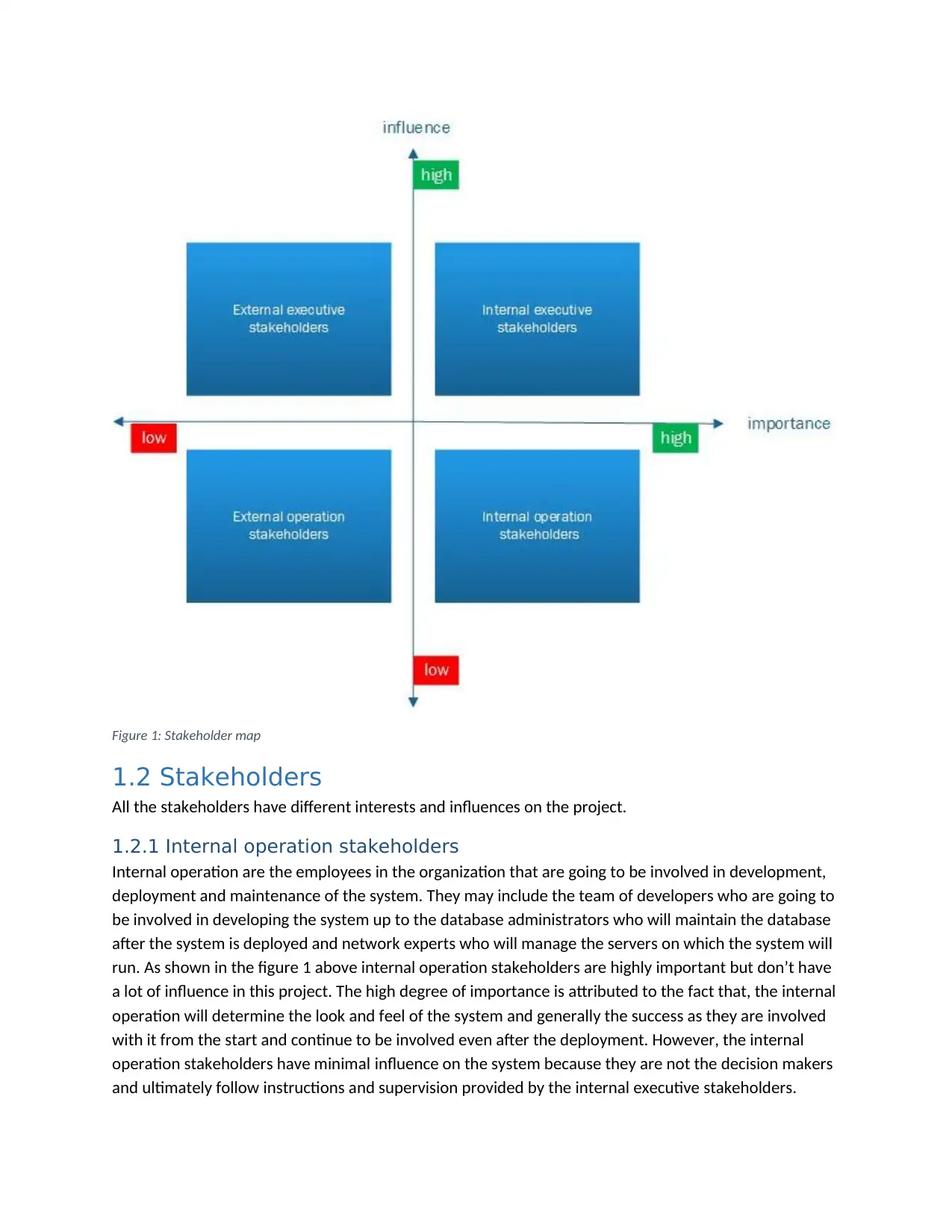
Figure 1: Stakeholder map
1.2 Stakeholders
All the stakeholders have different interests and influences on the project.
1.2.1 Internal operation stakeholders
Internal operation are the employees in the organization that are going to be involved in development,
deployment and maintenance of the system. They may include the team of developers who are going to
be involved in developing the system up to the database administrators who will maintain the database
after the system is deployed and network experts who will manage the servers on which the system will
run. As shown in the figure 1 above internal operation stakeholders are highly important but don’t have
a lot of influence in this project. The high degree of importance is attributed to the fact that, the internal
operation will determine the look and feel of the system and generally the success as they are involved
with it from the start and continue to be involved even after the deployment. However, the internal
operation stakeholders have minimal influence on the system because they are not the decision makers
and ultimately follow instructions and supervision provided by the internal executive stakeholders.
1.2 Stakeholders
All the stakeholders have different interests and influences on the project.
1.2.1 Internal operation stakeholders
Internal operation are the employees in the organization that are going to be involved in development,
deployment and maintenance of the system. They may include the team of developers who are going to
be involved in developing the system up to the database administrators who will maintain the database
after the system is deployed and network experts who will manage the servers on which the system will
run. As shown in the figure 1 above internal operation stakeholders are highly important but don’t have
a lot of influence in this project. The high degree of importance is attributed to the fact that, the internal
operation will determine the look and feel of the system and generally the success as they are involved
with it from the start and continue to be involved even after the deployment. However, the internal
operation stakeholders have minimal influence on the system because they are not the decision makers
and ultimately follow instructions and supervision provided by the internal executive stakeholders.
Paraphrase This Document
Need a fresh take? Get an instant paraphrase of this document with our AI Paraphraser
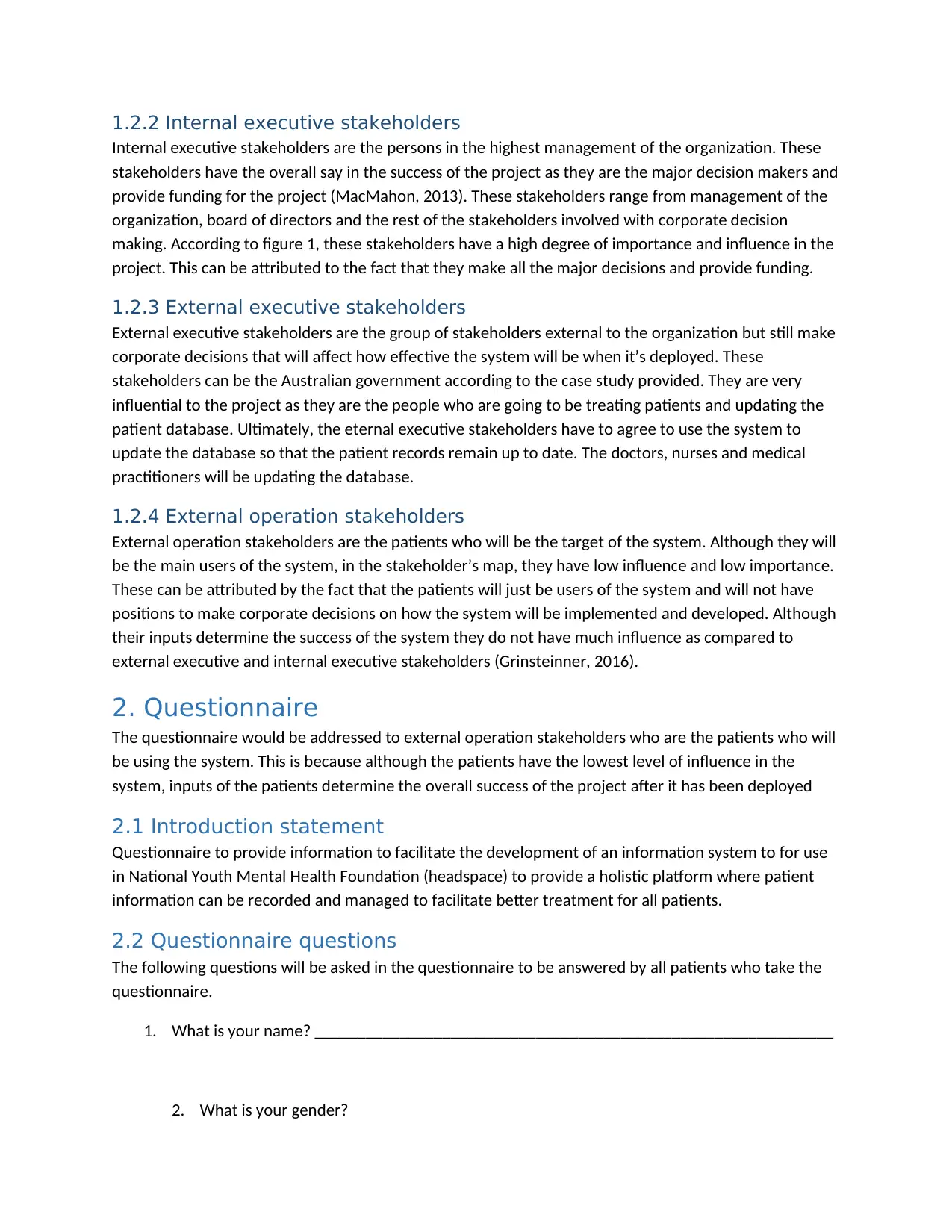
1.2.2 Internal executive stakeholders
Internal executive stakeholders are the persons in the highest management of the organization. These
stakeholders have the overall say in the success of the project as they are the major decision makers and
provide funding for the project (MacMahon, 2013). These stakeholders range from management of the
organization, board of directors and the rest of the stakeholders involved with corporate decision
making. According to figure 1, these stakeholders have a high degree of importance and influence in the
project. This can be attributed to the fact that they make all the major decisions and provide funding.
1.2.3 External executive stakeholders
External executive stakeholders are the group of stakeholders external to the organization but still make
corporate decisions that will affect how effective the system will be when it’s deployed. These
stakeholders can be the Australian government according to the case study provided. They are very
influential to the project as they are the people who are going to be treating patients and updating the
patient database. Ultimately, the eternal executive stakeholders have to agree to use the system to
update the database so that the patient records remain up to date. The doctors, nurses and medical
practitioners will be updating the database.
1.2.4 External operation stakeholders
External operation stakeholders are the patients who will be the target of the system. Although they will
be the main users of the system, in the stakeholder’s map, they have low influence and low importance.
These can be attributed by the fact that the patients will just be users of the system and will not have
positions to make corporate decisions on how the system will be implemented and developed. Although
their inputs determine the success of the system they do not have much influence as compared to
external executive and internal executive stakeholders (Grinsteinner, 2016).
2. Questionnaire
The questionnaire would be addressed to external operation stakeholders who are the patients who will
be using the system. This is because although the patients have the lowest level of influence in the
system, inputs of the patients determine the overall success of the project after it has been deployed
2.1 Introduction statement
Questionnaire to provide information to facilitate the development of an information system to for use
in National Youth Mental Health Foundation (headspace) to provide a holistic platform where patient
information can be recorded and managed to facilitate better treatment for all patients.
2.2 Questionnaire questions
The following questions will be asked in the questionnaire to be answered by all patients who take the
questionnaire.
1. What is your name? _____________________________________________________________
2. What is your gender?
Internal executive stakeholders are the persons in the highest management of the organization. These
stakeholders have the overall say in the success of the project as they are the major decision makers and
provide funding for the project (MacMahon, 2013). These stakeholders range from management of the
organization, board of directors and the rest of the stakeholders involved with corporate decision
making. According to figure 1, these stakeholders have a high degree of importance and influence in the
project. This can be attributed to the fact that they make all the major decisions and provide funding.
1.2.3 External executive stakeholders
External executive stakeholders are the group of stakeholders external to the organization but still make
corporate decisions that will affect how effective the system will be when it’s deployed. These
stakeholders can be the Australian government according to the case study provided. They are very
influential to the project as they are the people who are going to be treating patients and updating the
patient database. Ultimately, the eternal executive stakeholders have to agree to use the system to
update the database so that the patient records remain up to date. The doctors, nurses and medical
practitioners will be updating the database.
1.2.4 External operation stakeholders
External operation stakeholders are the patients who will be the target of the system. Although they will
be the main users of the system, in the stakeholder’s map, they have low influence and low importance.
These can be attributed by the fact that the patients will just be users of the system and will not have
positions to make corporate decisions on how the system will be implemented and developed. Although
their inputs determine the success of the system they do not have much influence as compared to
external executive and internal executive stakeholders (Grinsteinner, 2016).
2. Questionnaire
The questionnaire would be addressed to external operation stakeholders who are the patients who will
be using the system. This is because although the patients have the lowest level of influence in the
system, inputs of the patients determine the overall success of the project after it has been deployed
2.1 Introduction statement
Questionnaire to provide information to facilitate the development of an information system to for use
in National Youth Mental Health Foundation (headspace) to provide a holistic platform where patient
information can be recorded and managed to facilitate better treatment for all patients.
2.2 Questionnaire questions
The following questions will be asked in the questionnaire to be answered by all patients who take the
questionnaire.
1. What is your name? _____________________________________________________________
2. What is your gender?
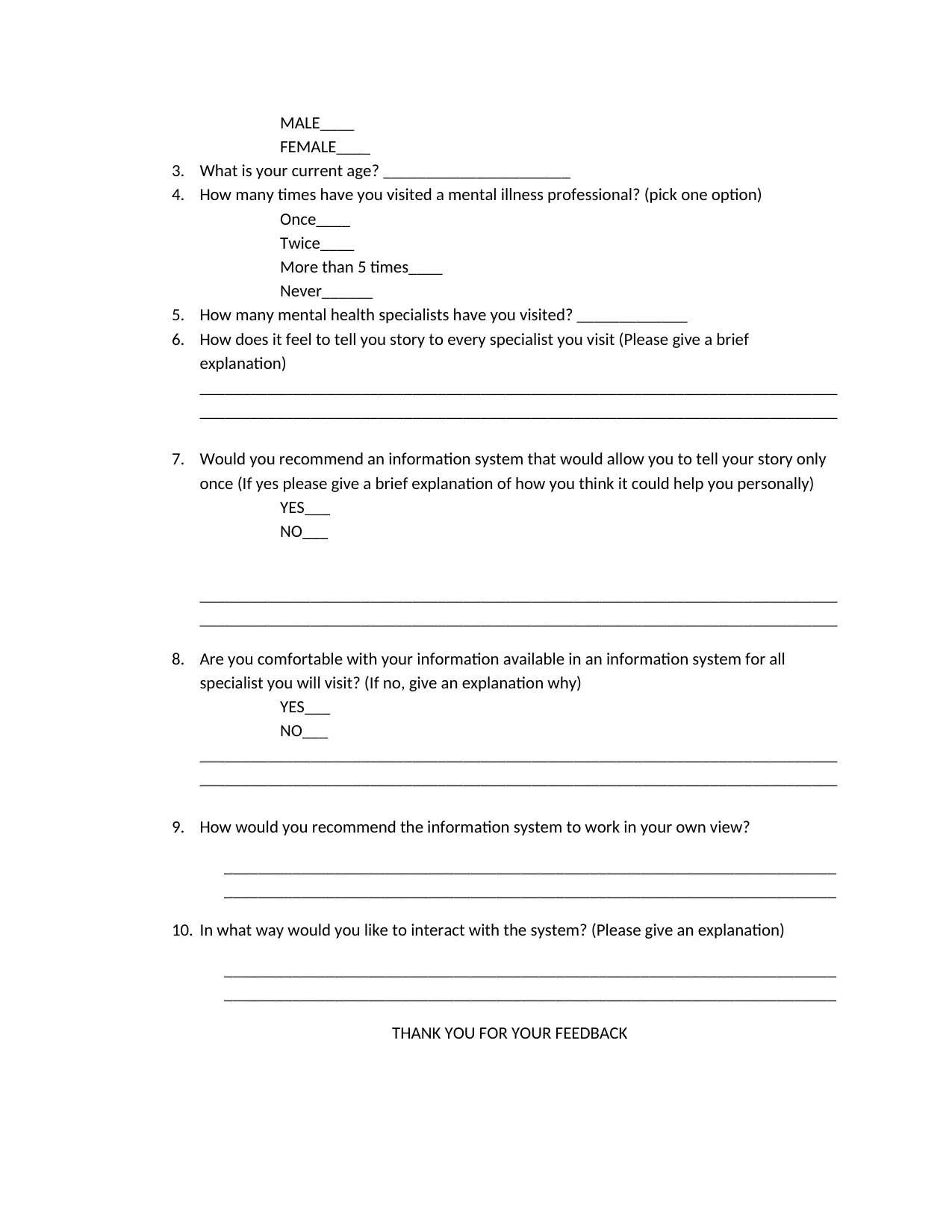
MALE____
FEMALE____
3. What is your current age? ______________________
4. How many times have you visited a mental illness professional? (pick one option)
Once____
Twice____
More than 5 times____
Never______
5. How many mental health specialists have you visited? _____________
6. How does it feel to tell you story to every specialist you visit (Please give a brief
explanation)
___________________________________________________________________________
___________________________________________________________________________
7. Would you recommend an information system that would allow you to tell your story only
once (If yes please give a brief explanation of how you think it could help you personally)
YES___
NO___
___________________________________________________________________________
___________________________________________________________________________
8. Are you comfortable with your information available in an information system for all
specialist you will visit? (If no, give an explanation why)
YES___
NO___
___________________________________________________________________________
___________________________________________________________________________
9. How would you recommend the information system to work in your own view?
________________________________________________________________________
________________________________________________________________________
10. In what way would you like to interact with the system? (Please give an explanation)
________________________________________________________________________
________________________________________________________________________
THANK YOU FOR YOUR FEEDBACK
FEMALE____
3. What is your current age? ______________________
4. How many times have you visited a mental illness professional? (pick one option)
Once____
Twice____
More than 5 times____
Never______
5. How many mental health specialists have you visited? _____________
6. How does it feel to tell you story to every specialist you visit (Please give a brief
explanation)
___________________________________________________________________________
___________________________________________________________________________
7. Would you recommend an information system that would allow you to tell your story only
once (If yes please give a brief explanation of how you think it could help you personally)
YES___
NO___
___________________________________________________________________________
___________________________________________________________________________
8. Are you comfortable with your information available in an information system for all
specialist you will visit? (If no, give an explanation why)
YES___
NO___
___________________________________________________________________________
___________________________________________________________________________
9. How would you recommend the information system to work in your own view?
________________________________________________________________________
________________________________________________________________________
10. In what way would you like to interact with the system? (Please give an explanation)
________________________________________________________________________
________________________________________________________________________
THANK YOU FOR YOUR FEEDBACK
⊘ This is a preview!⊘
Do you want full access?
Subscribe today to unlock all pages.

Trusted by 1+ million students worldwide
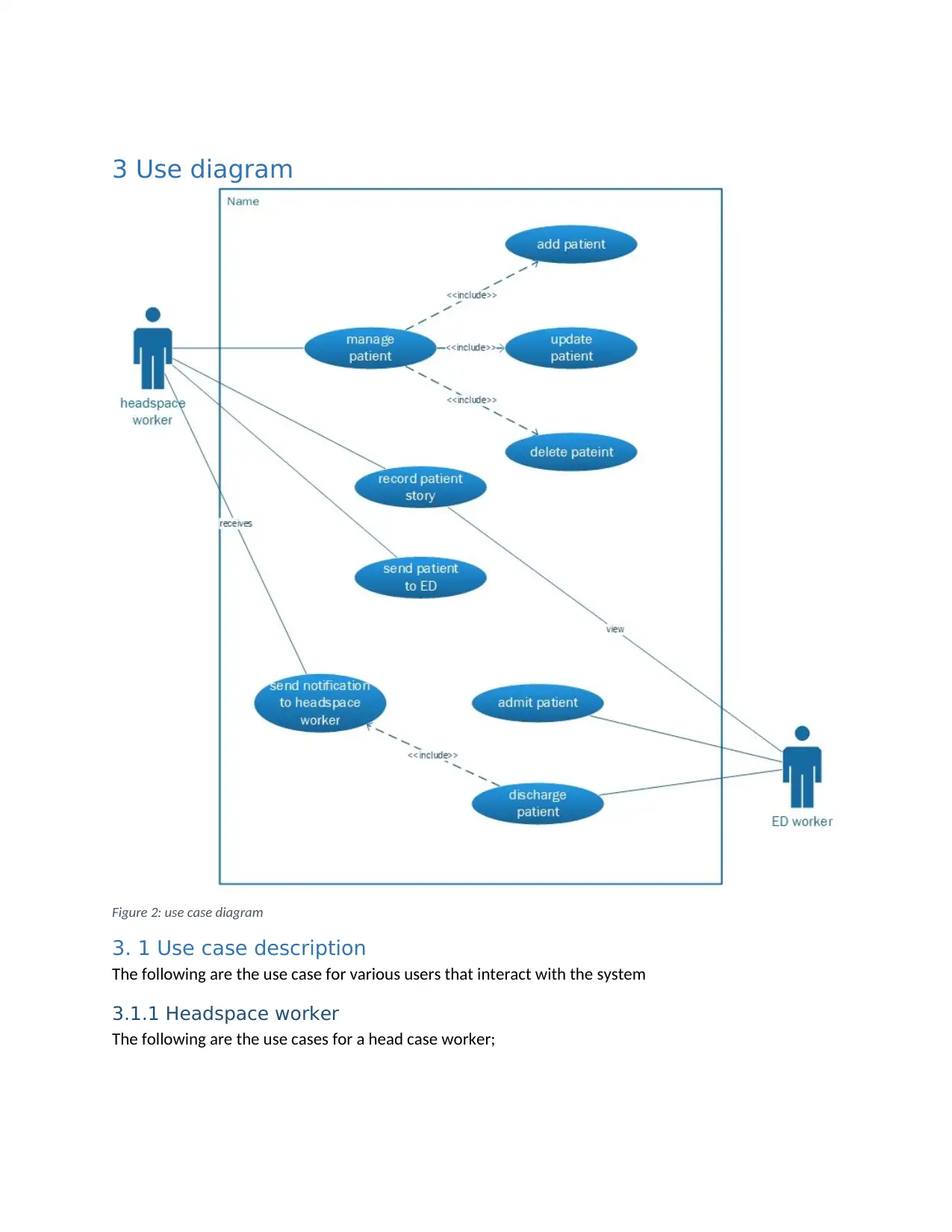
3 Use diagram
Figure 2: use case diagram
3. 1 Use case description
The following are the use case for various users that interact with the system
3.1.1 Headspace worker
The following are the use cases for a head case worker;
Figure 2: use case diagram
3. 1 Use case description
The following are the use case for various users that interact with the system
3.1.1 Headspace worker
The following are the use cases for a head case worker;
Paraphrase This Document
Need a fresh take? Get an instant paraphrase of this document with our AI Paraphraser
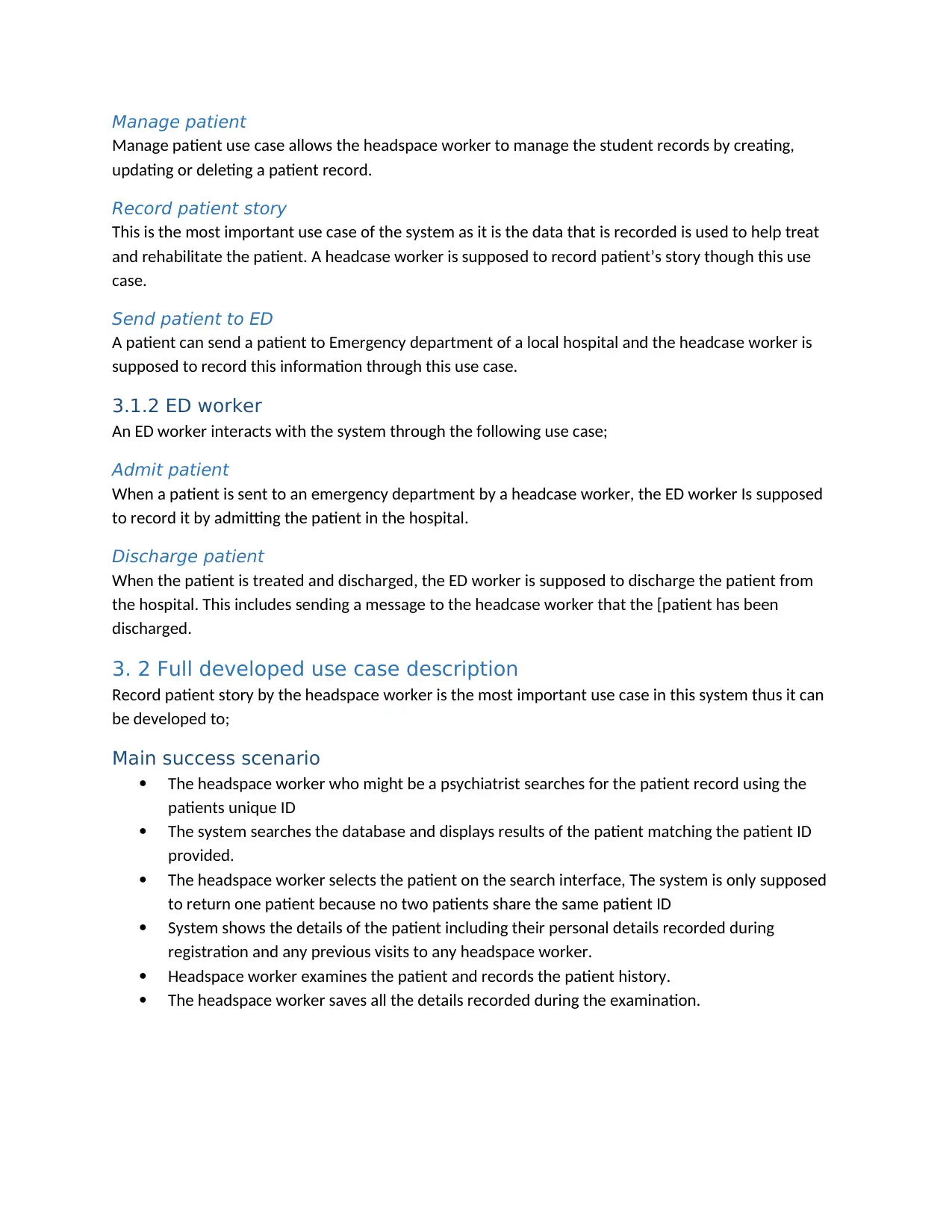
Manage patient
Manage patient use case allows the headspace worker to manage the student records by creating,
updating or deleting a patient record.
Record patient story
This is the most important use case of the system as it is the data that is recorded is used to help treat
and rehabilitate the patient. A headcase worker is supposed to record patient’s story though this use
case.
Send patient to ED
A patient can send a patient to Emergency department of a local hospital and the headcase worker is
supposed to record this information through this use case.
3.1.2 ED worker
An ED worker interacts with the system through the following use case;
Admit patient
When a patient is sent to an emergency department by a headcase worker, the ED worker Is supposed
to record it by admitting the patient in the hospital.
Discharge patient
When the patient is treated and discharged, the ED worker is supposed to discharge the patient from
the hospital. This includes sending a message to the headcase worker that the [patient has been
discharged.
3. 2 Full developed use case description
Record patient story by the headspace worker is the most important use case in this system thus it can
be developed to;
Main success scenario
The headspace worker who might be a psychiatrist searches for the patient record using the
patients unique ID
The system searches the database and displays results of the patient matching the patient ID
provided.
The headspace worker selects the patient on the search interface, The system is only supposed
to return one patient because no two patients share the same patient ID
System shows the details of the patient including their personal details recorded during
registration and any previous visits to any headspace worker.
Headspace worker examines the patient and records the patient history.
The headspace worker saves all the details recorded during the examination.
Manage patient use case allows the headspace worker to manage the student records by creating,
updating or deleting a patient record.
Record patient story
This is the most important use case of the system as it is the data that is recorded is used to help treat
and rehabilitate the patient. A headcase worker is supposed to record patient’s story though this use
case.
Send patient to ED
A patient can send a patient to Emergency department of a local hospital and the headcase worker is
supposed to record this information through this use case.
3.1.2 ED worker
An ED worker interacts with the system through the following use case;
Admit patient
When a patient is sent to an emergency department by a headcase worker, the ED worker Is supposed
to record it by admitting the patient in the hospital.
Discharge patient
When the patient is treated and discharged, the ED worker is supposed to discharge the patient from
the hospital. This includes sending a message to the headcase worker that the [patient has been
discharged.
3. 2 Full developed use case description
Record patient story by the headspace worker is the most important use case in this system thus it can
be developed to;
Main success scenario
The headspace worker who might be a psychiatrist searches for the patient record using the
patients unique ID
The system searches the database and displays results of the patient matching the patient ID
provided.
The headspace worker selects the patient on the search interface, The system is only supposed
to return one patient because no two patients share the same patient ID
System shows the details of the patient including their personal details recorded during
registration and any previous visits to any headspace worker.
Headspace worker examines the patient and records the patient history.
The headspace worker saves all the details recorded during the examination.
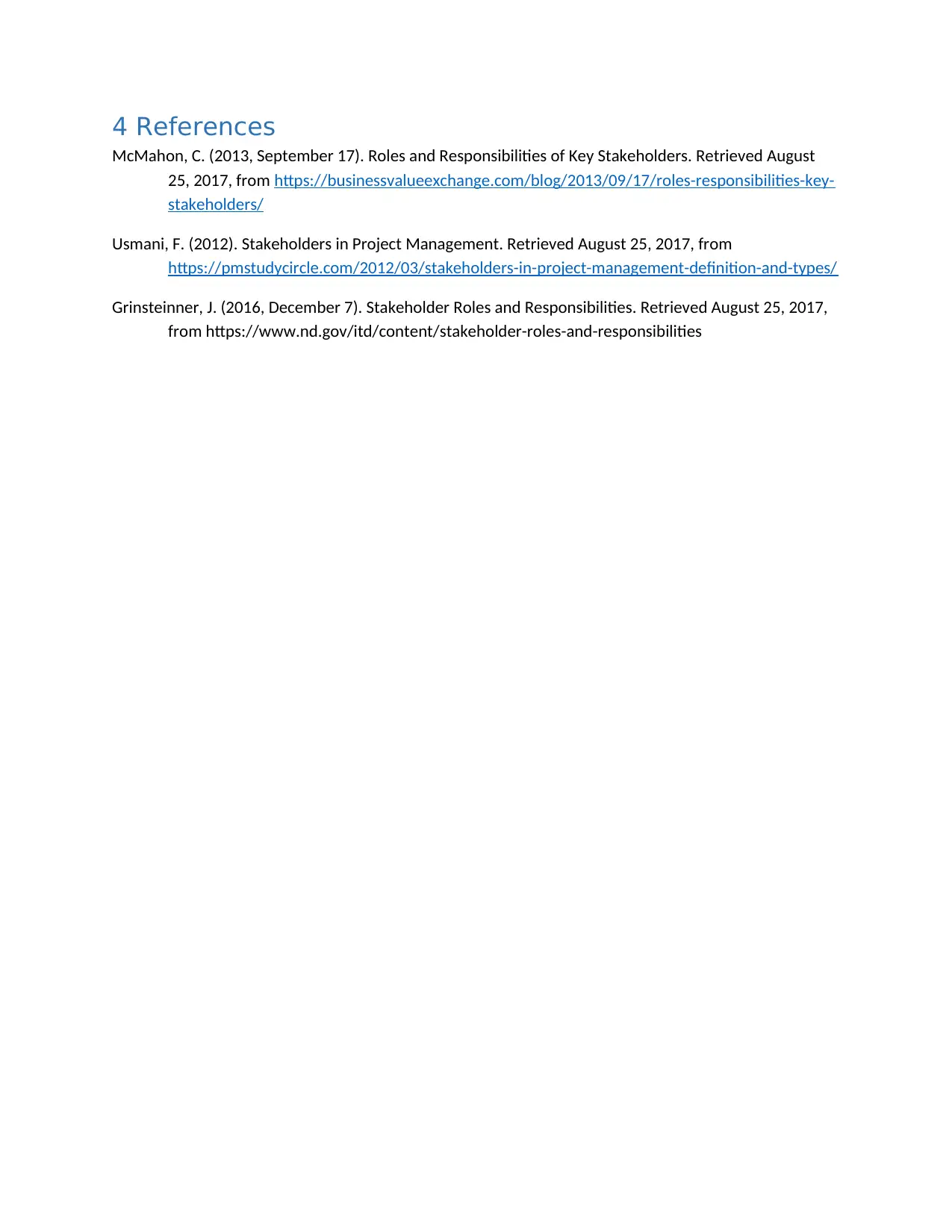
4 References
McMahon, C. (2013, September 17). Roles and Responsibilities of Key Stakeholders. Retrieved August
25, 2017, from https://businessvalueexchange.com/blog/2013/09/17/roles-responsibilities-key-
stakeholders/
Usmani, F. (2012). Stakeholders in Project Management. Retrieved August 25, 2017, from
https://pmstudycircle.com/2012/03/stakeholders-in-project-management-definition-and-types/
Grinsteinner, J. (2016, December 7). Stakeholder Roles and Responsibilities. Retrieved August 25, 2017,
from https://www.nd.gov/itd/content/stakeholder-roles-and-responsibilities
McMahon, C. (2013, September 17). Roles and Responsibilities of Key Stakeholders. Retrieved August
25, 2017, from https://businessvalueexchange.com/blog/2013/09/17/roles-responsibilities-key-
stakeholders/
Usmani, F. (2012). Stakeholders in Project Management. Retrieved August 25, 2017, from
https://pmstudycircle.com/2012/03/stakeholders-in-project-management-definition-and-types/
Grinsteinner, J. (2016, December 7). Stakeholder Roles and Responsibilities. Retrieved August 25, 2017,
from https://www.nd.gov/itd/content/stakeholder-roles-and-responsibilities
⊘ This is a preview!⊘
Do you want full access?
Subscribe today to unlock all pages.

Trusted by 1+ million students worldwide
1 out of 9
Related Documents
Your All-in-One AI-Powered Toolkit for Academic Success.
+13062052269
info@desklib.com
Available 24*7 on WhatsApp / Email
![[object Object]](/_next/static/media/star-bottom.7253800d.svg)
Unlock your academic potential
Copyright © 2020–2025 A2Z Services. All Rights Reserved. Developed and managed by ZUCOL.





